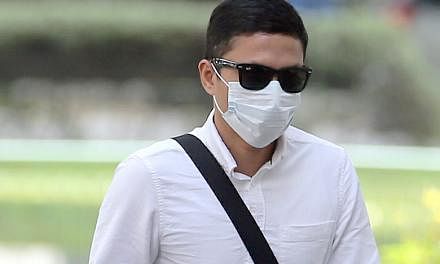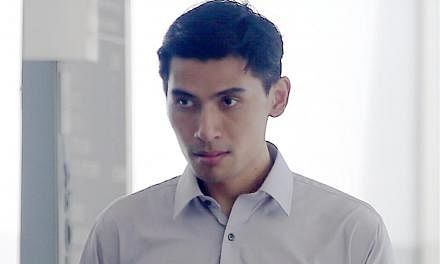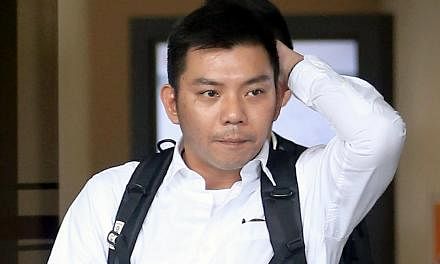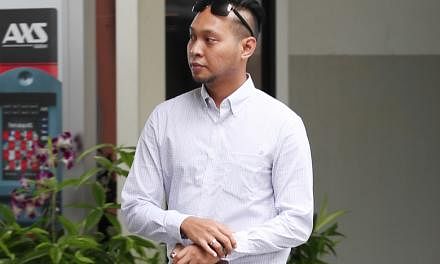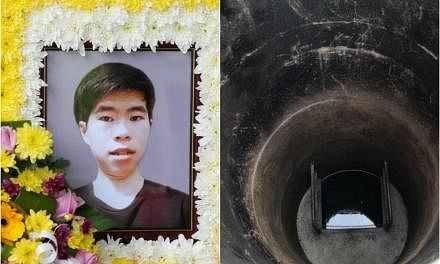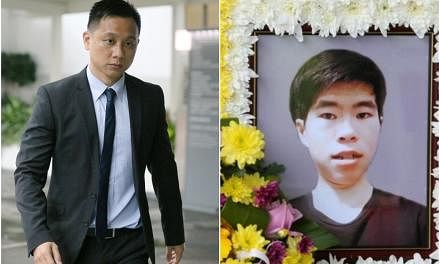SINGAPORE - When entering a pool of water, a person who does not know how to swim might not know to breathe in before entering, and to exhale slightly while submerged.
As a result, it is possible he might inhale water while submerged.
Forensic pathologist George Paul was pointing this out as he testified on Friday (June 14) in the ongoing trial of two commanders of the Singapore Civil Defence Force (SCDF) linked with the drowning of full-time national serviceman Corporal Kok Yuen Chin, which happened during a ragging incident.
Dr Paul, who performed the autopsy on Cpl Kok, said: "There is also a difference between how one reacts when he is prepared to enter the water or when it is a sudden unexpected event."
If it is unexpected, it could also result in a startled "inhalatory response" that causes the person to breathe in water, he said, adding that it is a common misconception that when somebody enters a body of water, he or she will float.
"When a body floats up, it is often because of decomposition. If a person has the presence of mind to tread water... he will come up. But if he does not... water rushes into the lungs and he goes deeper and deeper into the water, he might not come up," added Dr Paul.
On May 13 last year, Cpl Kok, a Malaysian national and Singapore permanent resident, was pushed into the Tuas View Fire Station's pump well as part of activities to mark the completion of his national service.
In his report dated May 14, Dr Paul stated that the 22-year-old died of drowning.
The two officers on trial - Kenneth Chong Chee Boon, 38, a lieutenant, and Nazhan Mohamed Nazi, 40, a first senior warrant officer - were rota commander and deputy rota commander respectively on the night of the incident.
Chong and Nazhan were each charged in July last year with aiding a rash act that caused grievous hurt by illegal omission.
They had allegedly failed to prevent a group of officers from making Cpl Kok enter the pump well, thereby endangering his life.
Testifying on the fifth day of the trial, Dr Paul said there is a difference between how a swimmer and non-swimmer handles himself when entering a body of water.
It had been earlier mentioned in court that the NSF did not know how to swim, and he had told this to at least one of his fellow SCDF officers in previous conversations.
Dr Paul said being submerged in the pump well, which is a dark and confined space, might also cause one to be disoriented, and could have been dangerous even for a swimmer.
"Instead of surfacing, you might go in the opposite direction," he said, adding that this was just his opinion based on conjecture.
In his autopsy report, Dr Paul noted that Cpl Kok's lips were blue from a lack of oxygen. Other signs including congested organs and the pooling of blood in some areas of the head indicated that he had drowned.
He also said Cpl Kok had small injuries on his limbs and face, which were not significant, and larger bruises on the back of his head.
Some of these, he said, could have come about during a struggle or through impact.
Dr Paul also said plant matter was found when he did a microscopic examination of Cpl Kok's lungs. It could have come from remnants of leafy materials or algae.
"This was certainly not clean water, and such water can have an irritant effect," he added.
Shortly after the autopsy, Dr Paul visited Tuas View Fire Station to take a look at the pump well as he wanted to understand more about the manner in which Cpl Kok died.
He inspected the well and noticed that there was a platform in it.
In blueprints of the well shown in court, the platform is located about halfway down the 12m-deep well. It has a 1m-wide hole in its centre that leads to the bottom.
During the rescue operations on May 13 last year, Cpl Kok was found and retrieved from this smaller hole.
Deputy Public Prosecutor Kumaresan Gohulabalan asked the doctor to comment on the possible injuries that could have resulted from the location where Cpl Kok was found.
The pathologist said it was possible the platform could have contributed to the injuries.
"Multiple contact with the platform could have contributed to the smaller injuries," said Dr Paul, adding that he could not be definitive about it.
The prosecution also took Dr Paul through some videos taken on the night of the incident. One in particular showed a close-up of Cpl Kok sitting on the edge of the well and being pushed in.
When asked to comment on it, Dr Paul observed that while Cpl Kok would have likely fallen in feet first, it was possible that he could have bent over so his head pointed downwards and this could have contributed to his head injuries.
When asked whether there was still the risk of drowning if Cpl Kok had not been pushed and had entered the well by gently lowering himself, Dr Paul said: "If he is not used to water rushing into his nose, it is still dangerous. If he is not used to exhaling while his head is submerged, he might still drown."
During cross-examination by Chong's defence lawyer Wee Pan Lee, Dr Paul acknowledged that the dim lighting around the well and the possible cloudy water in it could have caused one to be disoriented.
Mr Wee also asked if it would have been less dangerous if there was a contingency plan for a swimming instructor to pull the person out of the well as soon as he experiences difficulty.
On the night of the incident, one of the officers, who was a swimming instructor, was told to be prepared in case something goes wrong. In a video shown in court, he could be seen removing his boots as Cpl Kok was on the ledge.
However, Dr Paul said he was not confident that it would be less dangerous given that the person might be struggling and the instructor himself would be trying to stay afloat, coupled with the confined space of the well.
"I can only speculate that the swimming instructor might not have added much," said Dr Paul.
The trial continues later in the day.




